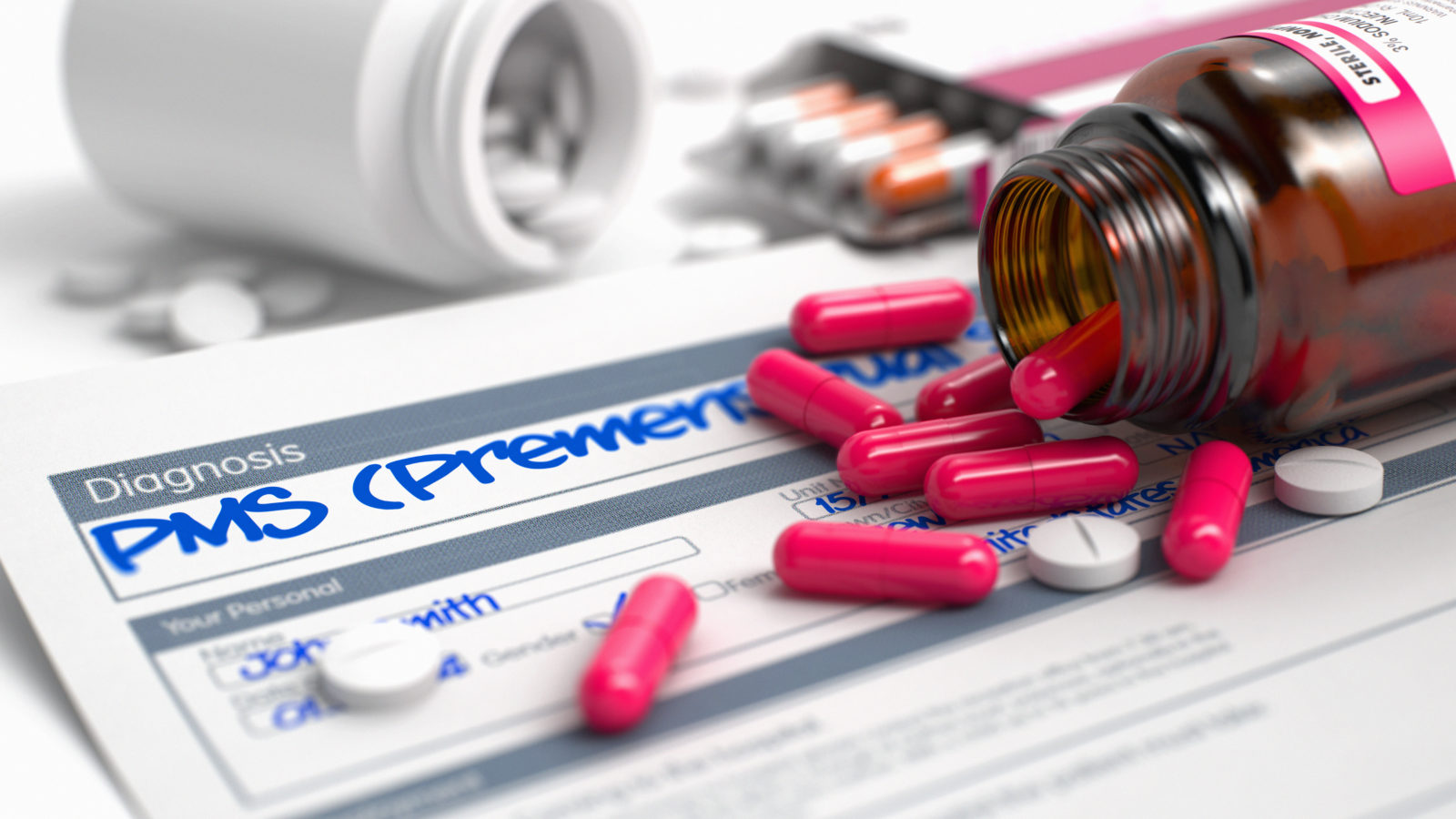Every woman is different and though there may be similarities in the reasons why one may experience PMS or Premenstrual Syndrome it is essential for you to understand your own body and listen to how it is doing and what exactly might be off with it. PMS does not just happen and you do not have to live with it.
What is PMS / Premenstrual Syndrome
PMS or Premenstrual Syndrome is a group of symptoms that begin to develop between two to one week prior to menstruation (around ovulation), desisting with the begin of menses. It can also occur after menses begins and last for the duration of the period of up until ovulation. PMDD or Premenstrual dysphoric disorder is a very severe form of PMS as it affects and interferes with your life.
Basically, it’s that time of the month when you don’t feel like doing anything, would rather stay in (possibly in bed with your PJ’s on), eat plenty of chocolate, bread with butter, Mac and cheese or other delicious junk food. You get moody, irritable and would rather have the company of the television than actual people. You feel bloated, puffy and maybe a little constipated.
The monthly rhythmic changes of the hormones within the body are influenced by the uterus, ovaries and their relation to the hypothalamus and pituitary glands. Premenstrual syndrome PMS is most often caused by an imbalance in hormones – this is often an issue with progesterone, GABA, serotonin or estrogen. Why hormones become imbalanced is a unique issue though oftentimes it is a result of the following (singularly or a combination);
Stress physiology
Dysglycemia
Mild Adrenal Insufficiency
Malnutrition
The hustle and bustle of modern life – the toxins- the lack of nutrients in the food we eat – the stressors – all these things negatively affect the human body.

Menstrual Cycle
There are three phases to a menstrual cycle the follicular phase comes first and lasts between 10 to 14 days, then comes the ovulatory phase which lasts about 36 hours and it is during this time that the egg is released. The last phase is the Luteal phase which concludes after 14 days. This is an average healthy menstrual cycle for women, however, as each woman is unique you can also have a healthier shorter or longer phase. Its consistency is important if it fluctuates from month to month that is a direct indication that your hormones are out of balance.
The uterus is receptive to implantation for a very short period of time each month – if the egg isn’t fertilized the uterus sheds its lining (aka – you get your period) and the menstrual cycle begins again.
The menstrual cycle is responsive to the changing levels of ovarian hormones in the blood (progesterone and estrogen) as well as the pituitary gonadotropic hormones FSH and LH.
The Follicular phase consists of the Menstrual and the Proliferative phases. During the menstrual phase, the thick endometrial lining of the uterus is detached from the wall of the uterus – followed by bleeding for 3 to 5 days – the menstrual flow or period which occurs around day five (5). This occurs as a result of the growth of ovarian follicles which stimulates the production of estrogen. At this time progesterone should stay low.
The Proliferative phase is reflective of growing estrogen levels in the blood which lasts from day 6 to 14 (on average) of the cycle. During this period the endometrium walls build itself back up and prepare itself for implantation.
Secretory Phases (part of the Luteal phase) is reflective of growing levels of progesterone. The rising levels of progesterone increase blood supply to the endometrium causing them to grow. This allows the lining to support the embryo until it is fertilized. If there is no fertilization the corpus luteum [short lived endocrine structure that forms within the ovary at the site of the released egg] stops producing hormones resulting in a drop in estrogen, progesterone, and LH in the blood. This eventually leads to a loss of blood supply to the endometrial wall starving it of nutrients, oxygen and leading to the detachment from the uterus. This results in menses and the beginning of the new cycle.
The length of the menstrual cycle can be the average 28 days, as short as 21 or as long as 40 days and still be healthy.
How do Hormones Influence PMS
When your hormones are not balanced you experience PMS or premenstrual syndrome, your cycle becomes unpredictable and you may even stop ovulating (this does not mean that you will stop menstruating).
Low Progesterone Levels
Most problems with premenstrual syndrome revolve around progesterone levels. Ovulation occurs midway through the cycle, around day 14 (average). When progesterone is imbalanced or if the body has a ‘resistance’ to it it can often trigger PMS around the time of ovulation. It brings about feelings of anxiety, a lack of calmness and mental clarity and results in a disruptive sleep cycle. This can have further implications for GABA receptors.
During the second half of the menstrual cycle, progesterone levels should become elevated, estrogen along with it – though only slightly. If progesterone is too low during this time it can vastly influence water retention, resulting in a feeling of fullness in the uterus as well as other areas of the body.
Lowered progesterone levels often result in estrogen dominance and can result in symptoms such as;
- rage
- headaches
- cysts
- sleep disorders
- painful periods
- weight gain
- mood swings – anxiety
- possible development of endometriosis
Too much STRESS can result in progesterone getting converted into cortisol – an abundance of cortisol can wreak havoc on the body. Higher levels of cortisol also block progesterone receptors (your serum levels may be high but you will feel the effects of low progesterone). This inevitably leads to PMS symptoms.
How to restore progesterone
- Vitamin C
- eliminate coffee, black tea, alcohol, dairy, sugar
- hang out with friends, join a team or club
- yoga and meditation – practice mindfulness
Serotonin Imbalance
A serotonin imbalance can often lead to symptoms of PMS or premenstrual syndrome. Serotonin is essential for the production of melatonin – your sleep hormone. It is a powerful antioxidant and aids in regulating your circadian rhythm. If it is out of balance and unable to dock to receptors in the brain it can also lead to an imbalance and overproduction of Cortisol -the stress hormone. Increase production of cortisol can not only result in changes in your mood but also have a negative effect on bloating and water retention (especially around your face). A serotonin imbalance can be treated with the supplementation of 5 HTP or Tryptophan.
When your serotonin levels are not in check you are very likely to experience cravings for sweets and sugar – this can occur for anyone, however, it is the persistence and worsening of hormonal balance in the female body at can result in other PMS symptoms. Further issues that can become prevalent for women with serotonin disruption are; overeating, lethargy (often in the way of watching too much television), extreme emotional outbursts and behavior as well as a dependency on neuro stimuli (ones that also lead to neurodegeneration) – alcohol, drug use, smoking.
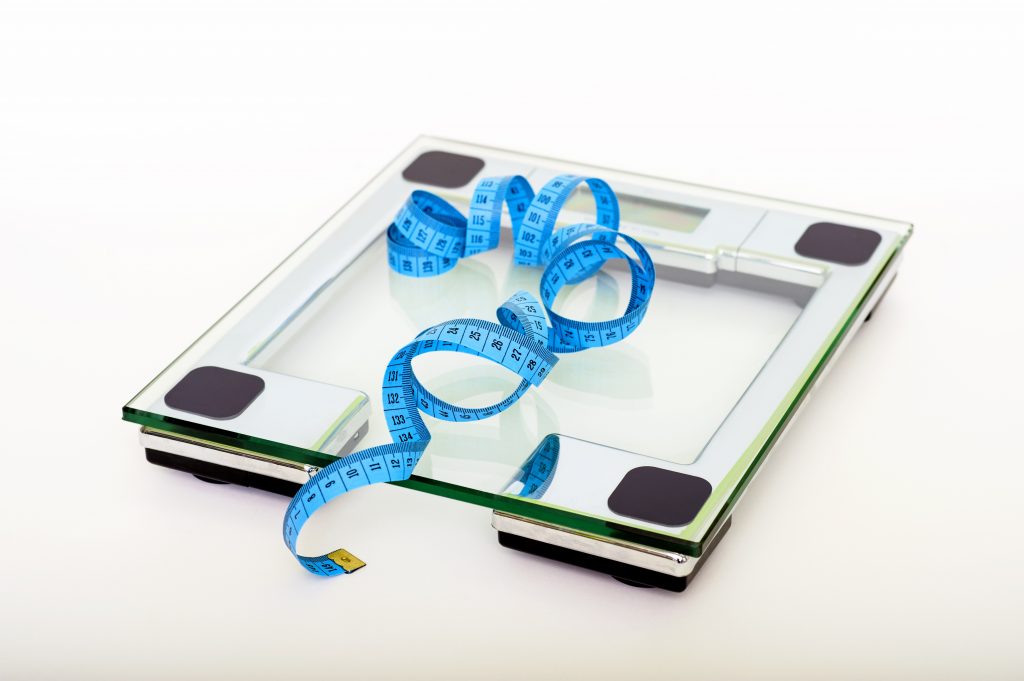

Low Estrogen Levels
Low estrogen serum levels can leave you feeling weak, moody and irritable and leave you to experience a very dry vagina. Low estrogen levels affect women in various ways – PMS symptoms;
- increasing appetite
- weight gain
- lack of good quality sleep or insomnia
- poor/low sex drive and/or painful periods
- poor fertility/infertility
- mood swings – irritability
- hot slashes/night sweats
- thinning hair
Having low body fat can also affect brain-hormone- fertility equilibrium. A BMI lower than 21% of total body mass can often result in lower estrogen levels in the body – and over time can lead to infertility.
Low estrogen levels can be a result of;
- food intolerances or allergies
- thyroid dysfunction
- breastfeeding – a temporary imbalance
- extreme exercising
A temporary decline in estrogen production also occurs when a baby is not carried to full term resulting in lower estrogen levels.
High Estrogen Levels
High levels of estrogen are far more common than low estrogen counts. You feel uncontrollably cranky (a symptom of PMS), everyone seems to annoy you and you get spouts of depression. Overweight women will often experience higher estrogen levels (comparable to normal progesterone levels) as fat cells make estrogen as well. The more fat cells in the body the more estrogen will be produced.
The most common form of estrogen excess is “estrogen dominance” in this instance estrogen levels are high while progesterone levels are low.
Reasons for elevated estrogen levels include the following;
- emotional stress
- environmental toxins – artificial forms of estrogen – xenoestrogen
- obesity and weight gain
- SAD diet – even a vegan or vegetarian diet
- eating disorders
- poor gut flora – dysbiosis
- mercury
- nutritional deficiency
How to prevent/restore estrogen levels
- reduce the consumption of coffee, alcohol, sugar, and dairy
- consume only grass-fed and finished, pastured and organic meats, dairy and eggs
- consume only small, sustainably caught seafood that is also low in mercury – to reduce toxicity buildup consume MSM after.
- eliminate all xenoestrogens
- bring health back to the gut
- exercise and practice mindfulness
- rebalance your circadian rhythm
- work on bringing balance and strength back into your adrenal glands.
If you have high estrogen levels it is important to get a regular mammogram done – as elevated estrogen levels can increase the likelihood of cancer.
The Importance of Estrogen
Estrogen is needed in the body, particularly the brain. This hormone – deemed the female hormone (though it is found naturally in males as well) is connected with the verbal and spatial memory centers of the brain. Estrogen is responsible for;
- supporting and strengthening the vaginal, urethral and vulvar tissues
- maintaining the integrity f the female reproductive organs
- giving your boobs and hips
- giving you smooth skin
- preparing the uterus for pregnancy
- balances serotonin levels ( which stimulates appetite, mood, sleep)
Health levels of estrogen prevent depression, loss of memory and inflammation – if the amounts are unfavorable these issues can become a problem. Furthermore, if estrogen becomes sufficiently deficient in the body for an extended period of time it can result in the permanent deterioration of the areas of the brain that require it to function.
Estradiol
Estradiol is the form of estrogen that is most abundant during the reproductive years for a woman therefore when the body is experiencing a decline or overabundance estradiol is the culprit.
The Importance of Progesterone
Progesterone is a hormone as well as a neurotransmitter, therefore it alters both the hormonal and neural pathways in the body when it is not balanced. It is necessary for soothing your mood and should leave you feeling level headed and relaxed.
Progesterone is also a major influence on GABA receptors, as a result, a deficiency in progesterone can also lead to a deficiency in GABA and dopamine. The other beneficial influencers progesterone has on the body includes the following;
- aids in reducing inflammation
- your period comes as a surprise
- regular periods – no spotting and no intensive flooding
- good quality sleep every night
How to Test Estrogen and Progesterone Levels
On Day 21 of your menstrual cycle take an estrogen and progesterone saliva test! This test will provide serum levels of estradiol and progesterone – you want to have a ratio of (Progesterone -Estradiol) 100 – 500 or 100 – 300.
Not all women with PMS will experience low Progesterone levels.
Different Types of PMS
- PMS A: Anxiety affects 80% of women with PMS or premenstrual syndrome. They often experience a mixture of emotions along with anxiety such as mood swings and irritability. Beneficial Herbs: Red clover, contains Vito estrogens, brings down testosterone. Ashwagandha. Beneficial Supplements: Magnesium Citrate.
- PMS H or W. Hyperhydration or Water Retention is a very common symptom of PMS or Premenstrual Syndrom. Bloating and weight gain affects 60% of women with premenstrual syndrome. This also includes breast swelling and tenderness. Resulted in an increased amount of aldosterone within the body. Beneficial Herbs: celery Seeds, Dandelion leaf (bitter). Do not take licorice root – salt cravings, stress makes a difference. Low magnesium and high estrogen. Beneficial Supplements: Potassium, B complex + additional B6. Regular Exercise
- PMS C. Carbohydrates and Cravings affect 40% of women with PMS or premenstrual syndrome, often resulting in an increased response to insulin. Sugar cravings (chocolate cravings) resulting in fatigue and headaches. Beneficial herbs: Evening Primrose, cinnamon. Beneficial Supplements: Chromium
- PMS D. Depression combined with confusion and memory loss (or brain fog). Higher progesterone to estrogen levels. Beneficial Herbs: St. John’s wort (used short-term for depression is okay, however, it should not be used for a long period of time), black cohosh – effects on pain. Beneficial Supplements: Zinc Citrate, Vitamin B6, Magnesium Citrate and Tryptophan or 5HTP.
- PMS P. Painful Periods or dysmenorrhea that is accompanied by acne, oily skin, cramps, lower back pain, nausea, and vomiting. Beneficial Herbs: Cramp bark – tincture- works amazingly, high bush cranberry. Beneficial Supplements: Vitamin E, Magnesium Citrate, Vitamin B6
Symptoms of Premenstrual Syndrome
There are over 150 different symptoms of PMS or premenstrual syndrome, and it is estimated at approximately 80% of women experience some symptoms of premenstrual syndrome.
- swelling of the breast and/or tenderness
- acne
- hot flashes – or an inability to regulate body temperature
- bloating – water retention
- digestive issues
- weight gain
- trouble sleeping
- headaches/migraines
- mood swings or irritability
- swelling of the feet and hands
- craving for sugar
- crying spells
- fatigue
- anxiety and depression
Premenstrual Dysphoric Disorder Symptoms
- suicidal thoughts
- sadness and despair
- panic attacks
- body aches
- mood swings and personality changes
- trouble focusing or brain fog
- extreme fatigue
- lack of interest in daily activity
- inability to hold up relationships romantically and socially
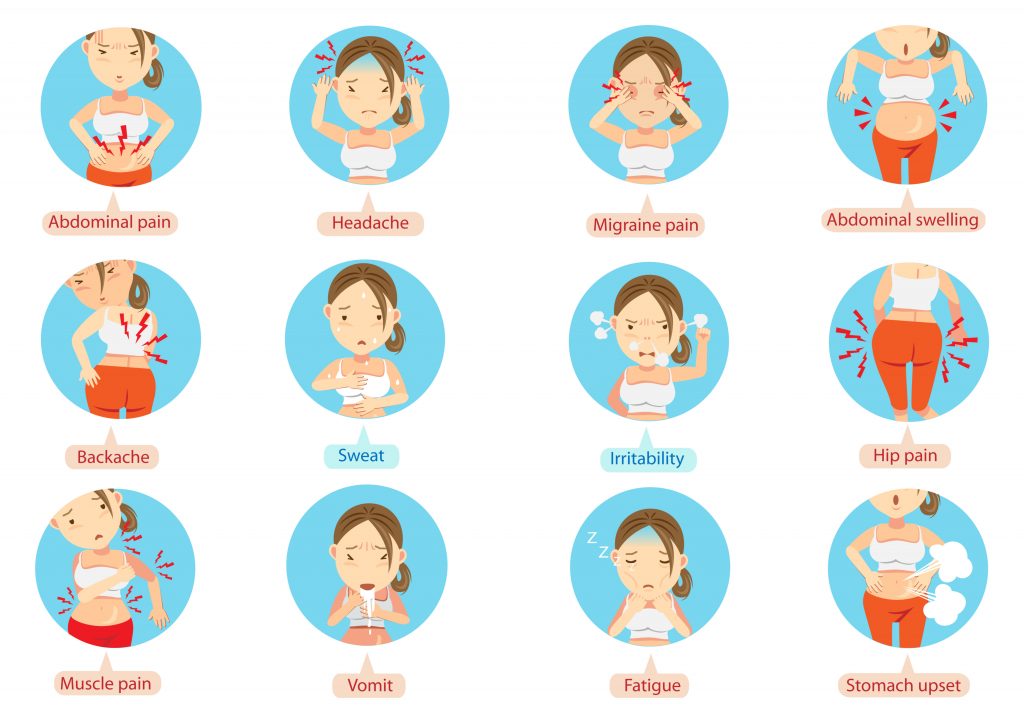
Food to Avoid when you have PMS
Women with PMS or premenstrual syndrome will consume more refined sugars (sweets, donuts, chocolate) than women without PMS symptoms. An imbalance in one’s blood sugar levels can often lead to a gorging of sweets, junk and processed goods – food such as these are laden with refined sugar. It is important to reduce the consumption of refined sugars, cane sugar, pops and fruit juices.
Sugars feed candida, which not only taxes the digestive system it also slows down the liver and can result in a build-up of certain hormones which inevitably displaces others.
Instead of sugar, get your sweetness from fruits and small amounts of honey, maple syrup or agave. Be mindful – if you’d like to have a slice of birthday cake have one but don’t feel bad.
Reduce the consumption of Dairy, Wheat, Alcohol, caffeine is imperative, as in the elimination of any and all foods that you are intolerant too or have an allergy to. Food additives and preservatives also place a very heavy burden on the digestive tract as well as the liver.
Cravings can be hard to kill, bringing mindfulness into your practice and daily routine can be very beneficial. You don’t want to restrict yourself from anything or make yourself feel bad. You do, however, want to become more intuned with your body. You should begin to understand what negatively affects your system and carry with yourself a positive mindset. Positivity can make a world of a difference.

Lifestyle Changes when you have PMS
Yoga & Meditation
Yoga is beneficial to the whole body, it aids in the motility of the digestive system, reduces inflammation, brings balance to hormones by reducing stress and allowing the individual to work under pressure and handle stressful situations better. It can also do wonders for reducing symptoms of PMS or premenstrual syndrome. Meditation and the practice of breathing can bring cleansing to the body. The functioning of the adrenal glands is another crucial part of overall health. They produce very beneficial hormones – such as cortisol – however, when the adrenal gland is out of flux it can wreak havoc on the levels of estrogen, progesterone and even serotonin in the body. Bring a little yoga and meditation into your lifestyle and aid in reducing stress and getting rid of your PMS or premenstrual syndrome.
Exercise
It is very important to be active, not overly active as extreme exercise can also result in premenstrual syndrome, however, begin a couch potato can be even worse. Regular walks, biking, light jogging, and swimming can be a very positive influence and aid in the balance of hormones and the alleviation of PMS premenstrual syndrome symptoms.
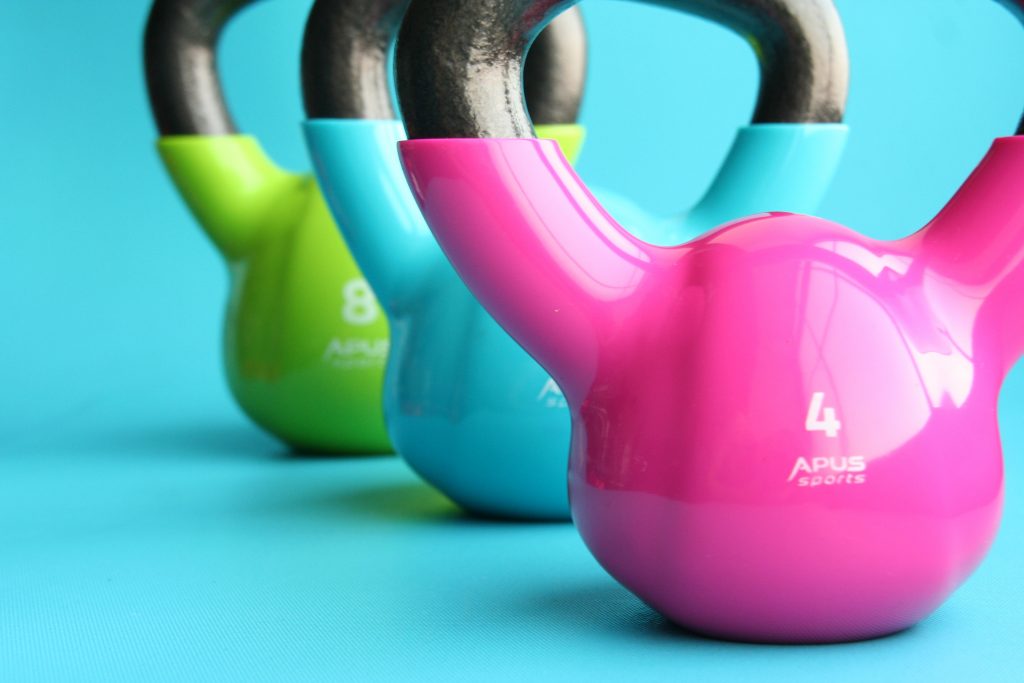
Digestion and PMS
These four steps are essential in your journey to rebalance your hormones and get rid of PMS. You cannot have a healthy body with an unbalanced digestive system. The gut has an amazingly expansive influence on the body, when it is not working accordingly it causes imbalances in the brain, thyroid, immune system, adrenal glands, and your ovaries.
- Remove: eliminate problem foods
- Replace: add digestive support to aid in absorbing minerals; enzymes, gentian root, bile acids (if one does not have a gallbladder)
- Reinoculate: Saccharomyces Boulardi – to aid against diarrhea, prebiotics, and probiotics
- Repair: flavonoids, minerals, and vitamins, NAG, essential fatty acids – anti-inflammatory
Stress Management
It is important to support adrenal glands so that you can get your cortisol levels stabilized and thought that process progesterone and estrogen. Properly functioning adrenal glands will also reduce your craving for sugar and bring down water retention. High-stress levels can make PMS symptoms much worse.
I highly recommend adding St. Francis’s Adrenal Tonic “Strest” to your daily supplement regimen. Begin with 3ml once a day for a week and move to 3mlx2 day continue for 5-6 weeks, stop for one week and continue again.
Diet
You should supplement with nutrients that you are deficient in however, you should also include nutrient-dense whole foods in your diet. Eating junk, or poor quality foods will not benefit your body. You want to give yourself strength and support your organs so that you can function optimally and bring your hormones into balance.
Instead of the coffee switch to green teas such as Sencha, matcha or Genmaicha. These teas are high in L-theanine, which aids in balancing hormones and elevating mood.
Curcumin/turmeric is a great addition to an anti-PMS diet. Turmeric and its derivative curcumin is a potent antioxidant, aiding in the reduction of inflammation, supporting liver function – primarily detoxification and intestinal health.

Birth Control Pill and PMS
As much as you may like it to, the Pill does not improve the symptoms of PMS or premenstrual syndrome, if anything it makes you feel a whole lot worse. The benefits of contraception are only one – you won’t get pregnant – and even for that, it is not 100% effective. Perhaps you are taking it to balance your hormone levels or aid against PCOS – here the thing, when your hormones are out of balance what you need is to bring them back into balance not scramble them up more. The PIll may make you feel better for a bit, for in honesty you will feel different from how you felt before, but it’s not a fix, it is just a band-aid and the issue is still there. It needs to be fixed because the longer your body is not functioning optimally the more issues it will have later on.
What does the Pill do to your body?
- It depletes your body of B Vitamins. These Vitamins are essential for proper brain function, digestive health, and nerve function. If you are feeling moody, have brain fog, aren’t going to the washroom at least twice daily, stressed, tired – you are probably depleting your body of B Vitamins.
- Contributed to symptoms of premenstrual syndrome – as a result of nutrient loss and hormonal changes.
- Contributed to weight gain and bloating.
- Though it may reduce your risk of certain cancers, it also elevated your risk of having breast cancer!
- It can increase the likelihood of blood clots.
Premenstrual Syndrom and Antidepressants
Antidepressants in the treatment of PMS should be a last resort after whole foods and a holistic approach has been tired. Premenstrual syndrome treated with antidepressants has been shown to aid in the balancing of serotonin levels which in some women has been shown to diminish PMS symptoms. However, there are numerous side effects of prolonged antidepressant use – one of which is the development of severe forms of depression.
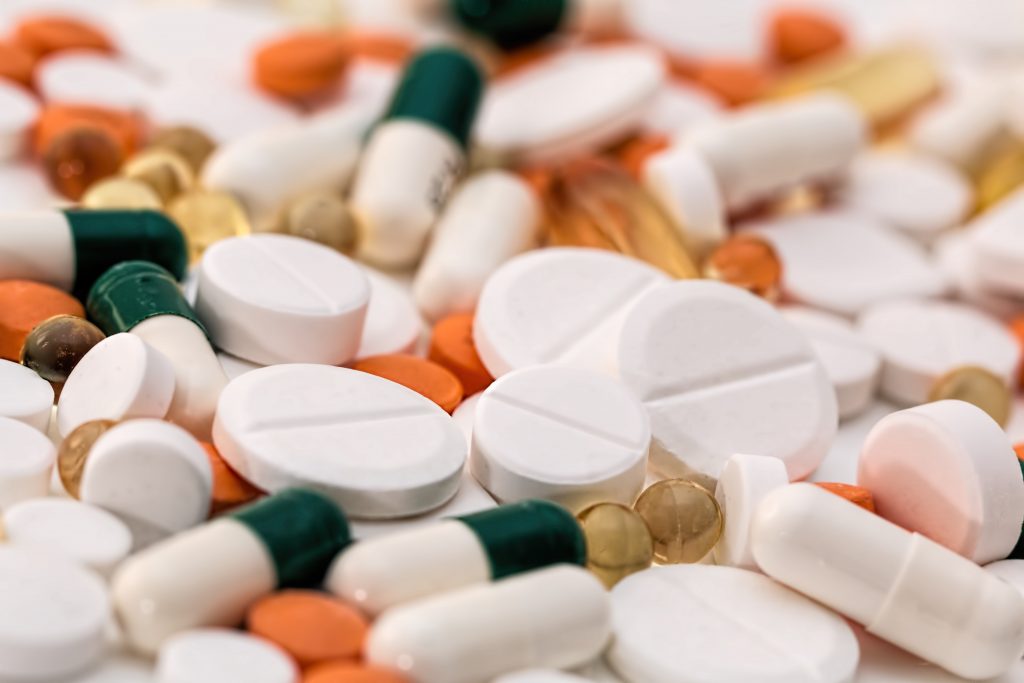
Supplements that Reduce the Symptoms of PMS
As PMS symptoms begin between two to one week before menstruation you want to introduce these nutrients into your body around that time or shortly before. This way you can see which benefit you and which do not. Taking all these supplements at once can be overwhelming.
MultiVitamin
This is essential if you are experiencing PMS. With the stress from your daily life (depletes vitamins and minerals), the pollution in our environments and bodies and the fact that a lot of the food we eat is not as nutrient-dense as it once was, filling in the gaps with a potent multivitamin is essential.
A one a day will not cut it as you want to provide your body with a steady flow of nutrients so that it can slowly rebuild its stores and use the nutrients to improve the bodies function.
After continuous use for between two weeks to a month, you should notice a difference and improvement.
Calcium
Many sources have suggested that the supplementation of calcium is very beneficial for individuals with premenstrual syndrome, however, it is very important to not consume too much calcium (as it can result in calcification and displacement of other minerals). With the way that many people eat, primarily individuals on a Standard American Diet they often get their recommended daily calcium intake from food. Consumption of dark leafy green vegetables and fortified dairy replacement products also provides ample amounts of calcium.
If you would like to supplement with it, begin with Calcium Citrate or Carbonate. Try it one week before your new cycle, or as soon as you begin to experience PMS or premenstrual syndrome symptoms. Supplement with 500-600 mg x2 daily for 5 days. Do not try any other supplements during the time (apart from multi and probiotics) so you can notice a difference. If it does not make a change, proceed to get calcium from your diet and multivitamin and look for help elsewhere.
Magnesium
Magnesium is the ‘elsewhere’. With the rush and stress of modern society, many of us quickly deplete our magnesium stores. Magnesium aids in reducing bloating and water retention, calming both the body and mind, reducing nervous tension, breast tenderness, headaches as well as aiding in providing more restful and healthy sleep.
Magnesium is food for the adrenals, liver, brain and the heart.
Supplementing with Magnesium Citrate before bed (as the powder will instruct – always starting with a smaller dose and working upwards) will aid in diminishing PMS symptoms and aid in regulating hormones. If you find that you are not sleeping properly, or you wake up feeling unrested it is a sure sign that you need to get your hormones in order.
Approximate dosage 300mg
Vitamin B6
Vitamin B6 or pyridoxine has been shown to assist individuals with depression that can be the result of using the Birth Control Pill or nutritional deficiency in the body. However, as for many B vitamins, it is essential that the individual has good gut bacteria as it will aid in the absorption of B6 and its conversion into its active form of pyridoxal-5-phosphate. B6 is also essential as it allows magnesium to enter the cells within the body – a deficiency in B6 will inevitably lead to a magnesium deficiency.
B6 also acts as a diuretic aiding in the elimination of excess water from the body.
Approximate dosage 25-50mg x 2 day
Tryptophan
An essential amino acid (meaning it cannot be produced by the body and needs to be derived from the diet) is the precursor for serotonin. It is required for normal growth as well as balancing nitrogen levels in the body. It crosses the blood-brain barrier. It is helpful in the treatment of depression, nightmares, headaches/migraines, fibromyalgia, and mood swings.
5-HTP
5-HTP or oxitriptan, like tryptophan, is a precursor for serotonin, however, unlike tryptophan, it is just one step away from the conversion of the hormone serotonin (and eventually melatonin). It is also helpful in the treatment of depression, nightmares, headaches/migraines, fibromyalgia, and mood swings.
Zinc
Zinc deficiency is very common among people. It is necessary for the formation of hormones and aids in their functioning – this is especially necessary for sex hormones (and later on for prolactin secretion – the ability for the female body to produce milk – low zinc = very little milk production). Zinc aids in raising serotonin levels in the body.
Vitamin E
Vitamin E ( preferably a supplement that does not contain any soy in it – sunflower is best) has been shown to be very beneficial for nervous tension, depression, headaches, insomnia, and fatigue. a simple dosage of 400 IU a day can make all the difference and reduce PMS symptoms.
Essential Fatty Acids – Borage, Primrose Oil, Black Currant
Including healthy fat in your diet makes can make a very positive impact on your life. EFAsare important for brain and skin health, it is essential for the transportation of hormones and the development and strength of neurotransmitters. Not only does it positively stimulate the brain, but it also aids in regulating body weight and helps you stay positive. Supplementing with GLA – gamma-linoleic acid in the form of evening primrose (9% GLA), blackcurrant (12% GLA) or borage oil (22% GLA) can significantly aid in lowering sugar cravings, and improving your mood.
Sneak this oil into a smoothie, salad dressing, or take a capsule.
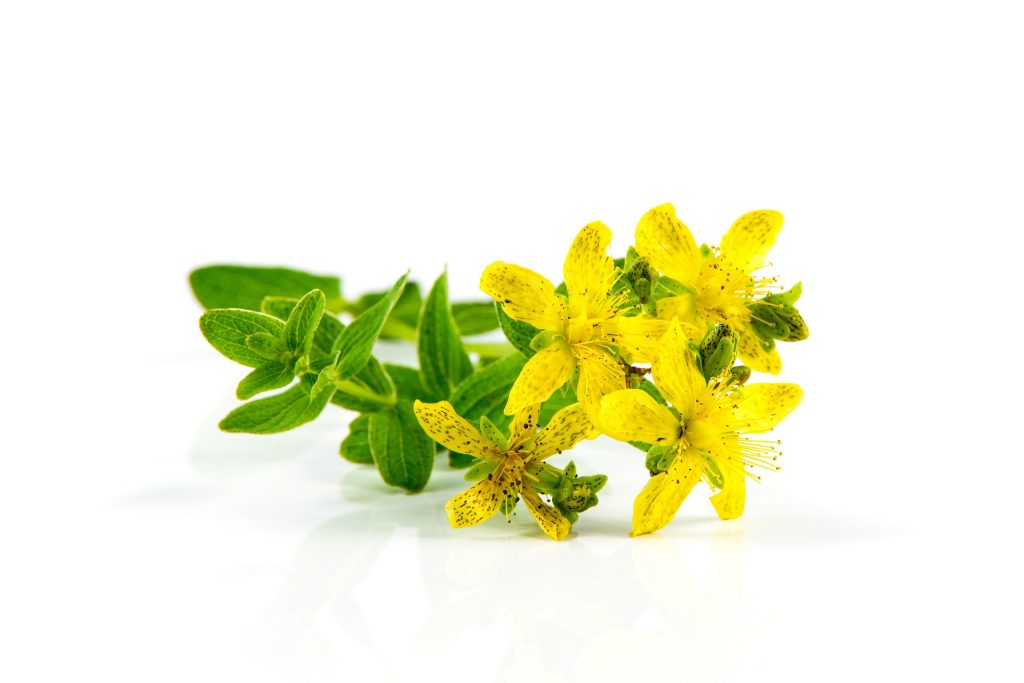
Herbal Medicine and PMS
If you have any questions about dosage or interactions between herbs and supplements or drugs make sure to contact a registered herbalist or your health practitioner. Herbal medicine thought effective can be very potent.
Chasteberry or Vitex
- Greatly relieves premenstrual syndrome symptoms though it may require a few months of prolonged use in order for the benefits to be seen.
- Beneficially works on the hypothalamus, aiding in the increase of luteinizing hormones, and increasing the production of progesterone.
- Leaves can be used in tea. A pituitary tonic and aids in balancing hormones – decreases progesterone levels to normal (for women).
- It helps to re-establish menstruation. Safe for the long term. Gets hormones into equilibrium. Works the best, when taken at (4 am) —, can take it before bed as soon as you wake up, look out the window. 40 drops 3 1/2 ml – before bed
- Do not stop taking it after things have normalized – reduce to half a dose, and continue this process until you can get off.
- Some people may need to take it forever 20 drops before bed
- Has a bitter undertone
St. John’s Wort
Increases serotonin levels – however, if you are taking antidepressants DO NOT take any form of St. John’s Wort.
- St. John’s Wort is used in the treatment of depression, PMS and menopause
- It has anti-inflammatory benefits – beneficial for the gut and the brain
- Aid in the elimination of PMS symptoms such as anxiety tiredness, poor appetite, and aiding in establishing good quality restful sleep.
- It has also been shown to balance hormones
300-900 mg x1 daily of a tincture can be very beneficial for the elimination of PMS symptoms. If a tincture is not your thing you can also try a tea. Either add a fresh sprig of St. John’s Wort into your tea and let it steep for 5 minutes or have one to two cups of bagged tea daily.
Cramp Bark
This North American plant has been used traditionally for reducing swollen lymph glands, reducing fluid retention, alleviating muscle cramps and spasms. Take it as needed. It is beneficial to take it before bedtime as it can also promote restful sleep. Best taken as a tincture, mixed with warm or hot water.
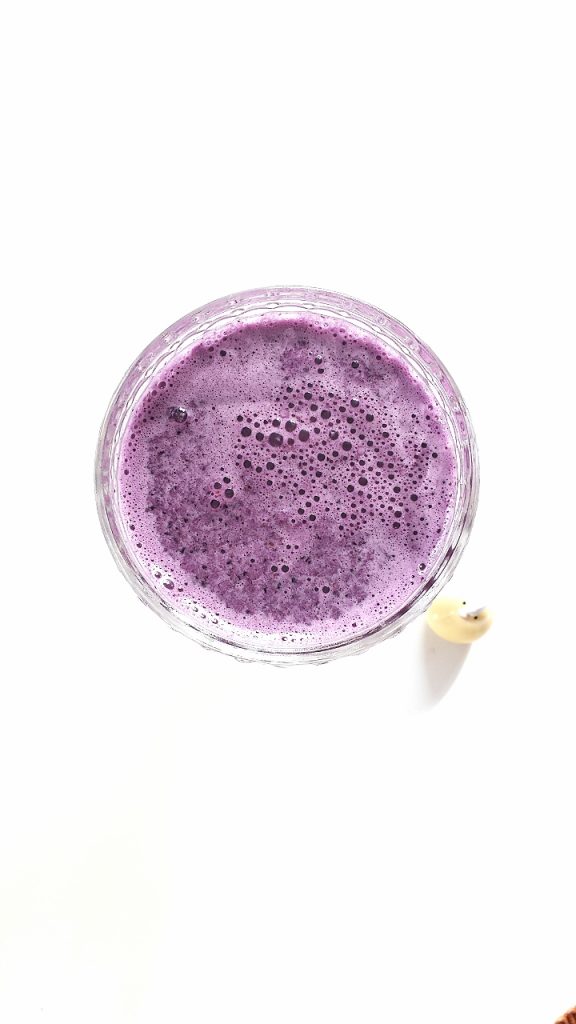
Detox and PMS
Some research has noted that approximately 75% of women with premenstrual syndrome have higher estrogen levels compared to progesterone levels which are often a result of oestrogen/oestradiol mimicking chemicals such as detergents, plastics, receipt paper, pesticides, some makeup, and food.
Doing a cleanse, to clean out the kidneys, liver and digestive tract can be very beneficial for the body and aid in the diminishing of PMS symptoms. A sluggish liver can often result in an overabundance of estrogen. However, make sure that your body is prepared for a cleanse as it can be tasking on your mental and physical self as it is being done.
Supplement or incorporate into your diet dandelion root, milk thistle, vitamin c and make sure to support a healthy digestive system.
References
Akbarzadeh, M., Dehghani, M., Moshfeghy, Z., Emamghoreishi, M., Tavakoli, P., & Zare, N. (2015). Effect of Melissa officinalis Capsule on the Intensity of Premenstrual Syndrome Symptoms in High School Girl Students. Nursing and midwifery studies, 4(2), e27001.
Bertone-Johnson, E. R., Hankinson, S. E., Forger, N. G., Powers, S. I., Willett, W. C., Johnson, S. R., & Manson, J. E. (2014). Plasma 25-hydroxyvitamin D and risk of premenstrual syndrome in a prospective cohort study. BMC women’s health, 14, 56.
Buddhabunyakan, N., Kaewrudee, S., Chongsomchai, C., Soontrapa, S., Somboonporn, W., & Sothornwit, J. (2017). Premenstrual syndrome (PMS) among high school students. International journal of women’s health, 9, 501-505.
Chen, H. Y., Huang, B. S., Lin, Y. H., Su, I. H., Yang, S. H., Chen, J. L., Huang, J. W., … Chen, Y. C. (2014). Identifying Chinese herbal medicine for premenstrual syndrome: implications from a nationwide database. BMC complementary and alternative medicine, 14, 206.
Chocano-Bedoya, P. O., Manson, J. E., Hankinson, S. E., Willett, W. C., Johnson, S. R., Chasan-Taber, L., Ronnenberg, A. G., Bigelow, C., … Bertone-Johnson, E. R. (2011). Dietary B vitamin intake and incident premenstrual syndrome. The American journal of clinical nutrition, 93(5), 1080-6.
Dadkhah, H., Ebrahimi, E., & Fathizadeh, N. (2016). Evaluating the effects of vitamin D and vitamin E supplement on premenstrual syndrome: A randomized, double-blind, controlled trial. Iranian journal of nursing and midwifery research, 21(2), 159-64.
Doll, H., Brown, S., Thurston, A., & Vessey, M. (1989). Pyridoxine (vitamin B6) and the premenstrual syndrome: a randomized crossover trial. The Journal of the Royal College of General Practitioners, 39(326), 364-8.
Ebrahimi, E., Khayati Motlagh, S., Nemati, S., & Tavakoli, Z. (2012). Effects of magnesium and vitamin b6 on the severity of premenstrual syndrome symptoms. Journal of caring sciences, 1(4), 183-9.
Figert, A.E. (1996). Women and the Ownership of PMS. Aldine Transaction; London.
Flawes, B. (1997). Curing PMS Naturally with Chinese Medicine. Blue Poppy Press: Boulder.
Gladstar, R. (1993). Herbal Healing for Women. New York: Fireside.
Gottfried, S. (2013).The Hormone Cure. New York: Scribner.
Hass, E.M., & Levin, B. (2006).Staying Healthy with Nutrition. The Complete Guide to Diet and Nutritional Medicine.United States: Celestial Arts.
Hoffman, D. (1990). Holistic Herbal. A Safe and Practical Guide to Making and Using Herbal Remedies. London: Thorsons.
Holford, P. (2009).The Optimum Nutrition Bible. London: Piatkus.
Houghton, S. C., Manson, J. E., Whitcomb, B. W., Hankinson, S. E., Troy, L. M., Bigelow, C., & Bertone-Johnson, E. R. (2018). Carbohydrate and fiber intake and the risk of premenstrual syndrome. European journal of clinical nutrition, 72(6), 861-870.
Hoyer, J., Burmann, I., Kieseler, M. L., Vollrath, F., Hellrung, L., Arelin, K., Roggenhofer, E., Villringer, A., … Sacher, J. (2013). Menstrual cycle phase modulates emotional conflict processing in women with and without premenstrual syndrome (PMS)–a pilot study. PloS one, 8(4), e59780.
Jang, S. H., Kim, D. I., & Choi, M. S. (2014). Effects and treatment methods of acupuncture and herbal medicine for premenstrual syndrome/premenstrual dysphoric disorder: a systematic review. BMC complementary and alternative medicine, 14, 11.
Kharrazian, D. (2010).Why Do I Still Have Thyroid Symptoms? When My Lab Tests Are Normal.California: Elephant Press.
Kharrazian, D. (2013).Why Isn’t My Brain Working? California: Elephant Press.
Khayat, S., Kheirkhah, M., Behboodi Moghadam, Z., Fanaei, H., Kasaeian, A., & Javadimehr, M. (2014). Effect of treatment with ginger on the severity of premenstrual syndrome symptoms. ISRN obstetrics and gynecology, 2014, 792708.
Khine, K., Rosenstein, D. L., Elin, R. J., Niemela, J. E., Schmidt, P. J., & Rubinow, D. R. (2005). Magnesium (mg) retention and mood effects after intravenous mg infusion in premenstrual dysphoric disorder. Biological psychiatry, 59(4), 327-33.
Koleini, S., & Valiani, M. (2017). Comparing the Effect of Auriculotherapy and Vitamin B6 on the Symptoms of Premenstrual Syndrome among the Students who Lived in the Dorm of Isfahan University of Medical Sciences. Iranian journal of nursing and midwifery research, 22(5), 354-358.
Maddineshat, M., Keyvanloo, S., Lashkardoost, H., Arki, M., & Tabatabaeichehr, M. (2016). Effectiveness of Group Cognitive-Behavioral Therapy on Symptoms of Premenstrual Syndrome (PMS) . Iranian journal of psychiatry, 11(1), 30-6.
Maleki-Saghooni, N., Karimi, F. Z., Behboodi Moghadam, Z., & Mirzaii Najmabadi, K. (2018). The effectiveness and safety of Iranian herbal medicines for the treatment of premenstrual syndrome: A systematic review. Avicenna journal of phytomedicine, 8(2), 96-113.
Marieb, E.M. (2012). Essentials of Human Anatomy and Physiology. Illinois: Pearson.
Moe, B. (2002). With PMS. The Rosen Publishing Group: New York.
Mohebbi Dehnavi, Z., Jafarnejad, F., & Sadeghi Goghary, S. (2018). The effect of 8 weeks aerobic exercise on the severity of physical symptoms of premenstrual syndrome: a clinical trial study.BMC women’s health, 18(1), 80.
Murray, M.T., & Pizzorno, J. (2012).The Encyclopedia of Natural Medicine.Third Edition. New York: Atria Paperback.
Parker, J. (2013). PMS and Women’s Health. eFortune.
Schauch, M. (2012).Making Sense of Women’s Health. A Naturopathic Solution.Ontario: ActNatural Corporation.
Tierra, M. (1998). The Way of Making Herbs. New York: Pocket Books.
Wu, M., Liang, Y., Wang, Q., Zhao, Y., & Zhou, R. (2016). Emotion Dysregulation of Women with Premenstrual Syndrome. Scientific reports, 6, 38501.
Amanda Filipowicz is a certified nutritional practitioner (CNP) with a bachelor in environmental studies (BES) from York University. She also has certification in clinical detoxification, prenatal and postnatal care as well as nutrition for mental health. She has been working as a nutritionist since 2013 and is a lifelong proponent of eating healthy.

